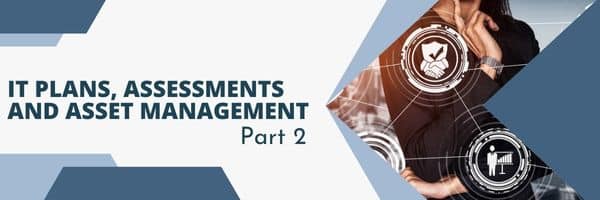In part 1 of this article, IT Plans, Assessments, and Asset Management we learned about IT Plans and Strategy. If you haven’t read that yet, go back and give it a read. It will help to have that information before we talk about IT budgets and asset management.
How do IT leaders forecast and budget for the IT team?
You probably did not get into technology to forecast and manage budgets. But understanding how your department spends money is important to your success as an IT manager. After all, you are responsible for setting and achieving your team’s strategic plans — it requires resources to do so. You need a solid understanding of what you want to achieve and the budget it will take to get there — from ongoing expenses to fixed budgets for projects or initiatives. You may also be involved in setting goals and budgets for headcount and hiring plans.
Knowing the investment, it will take to reach your goals makes it easier to negotiate a budget with company executives. This is especially true when you need to get budget approvals from company leaders who still view IT as a cost center. If you can explain the impact that your initiative will have, you can make a stronger argument for the resources you need.
What is the difference between forecasting and budgeting?
Forecasting and budgeting are similar exercises that help you capture and evaluate your department’s financial needs. But there are some important distinctions:
What is:
- Forecasting – it is the process of estimating what you will need in the future. It requires comparing your current expenses to future plans to project the resources you will need.
- Budgeting – it is the annual, biannual, or quarterly process of drafting a spending plan for how the IT department will use the resources you are allocated.
Why use it?
- Forecasting helps you predict how accurate your current budget is — whether you will spend more or less than you planned for each area of investment. Its aim is to identify and analyze patterns to improve your ability to set budgets in the future.
- Budgeting helps you determine how you will accomplish your goals with the tools and resources you have. It forces you to make prioritized decisions about where to invest based on what has been allocated to you.
When to use it
- Forecasting typically occurs for a specific period (e.g., forecasting the funds you will need for the year ahead). However, you will also continually forecast the costs of new initiatives or tools as you receive requests from other teams. This information informs ongoing forecasting.
- Budgeting is a discrete task aligned with company planning periods — typically done annually, biannually, or quarterly. Of course, you should review your budget periodically and adjust as needed.
Why are forecasting and budgeting important?
Although the IT team may not directly drive revenue or interact with external customers, your work is essential to improving how the organization functions. Proper forecasting and budgeting enable you to acquire company resources and use them more efficiently — so you can focus on the work of maintaining and optimizing technology.
But there are many other benefits to creating accurate forecasts and budgets. One is accountability. A budget is a commitment — you can only spend the dollars you have for a given project. Staying within that budget requires smart planning and the efficient use of resources. You need to distill the IT goals into their most fundamental units of work, so the team asks for and invests only in the projects that will help you achieve your objectives.
The act of building and forecasting budgets also requires transparency. You are providing visibility into your department’s areas of focus and how each contributes to broader company goals. For example, if you want to update your architecture or technology stack, you must be able to articulate the “why” behind these initiatives — what makes them worth pursuing and how they directly contribute to company goals.
Accurate forecasting is especially useful for planning purposes. Having a firm grasp of how your ongoing expenses may change in the next quarter or year helps to mitigate risk and reduce surprises. For instance, if your organization is in the early stages of implementing a data transformation, you can anticipate the additional expenditures required and temporarily reallocate your budget.
Prepare in advance for tough questions from company leaders. They will want to understand the big-picture impact of what you are proposing. For example, if you are advocating for a new security or monitoring tool, be ready to talk about its benefits. Executives may not care about specific features but will care about the broader business implications or impact on the team.
Ensure that your IT efforts are aligned with business goals and success metrics. In this way, you can continue to put goals first and make informed decisions about the budget.
IT infrastructure assessment checklist
IT powers your business. In the modern workplace, even a small issue with your IT infrastructure can cause disruptions to routine business operations — resulting in data issues, downtime, and security vulnerabilities. A detailed IT assessment can help you identify areas of weakness in your environment. This guide includes a checklist to help you assess the following:
- IT strategy and performance
- Data and cloud storage
- Hardware and software capabilities
- Risk management and compliance
- Workflows and other procedures
The Assessment Prep Tool is a good starting point. But you will want to compile your own checklist based on your organization, industry, and unique needs.
What is an IT assessment?
An IT assessment is the formal process of analyzing all the data, systems, and procedures in your IT environment. It helps you evaluate the state of your environment today — so you can identify and prioritize critical areas to improve, such as outdated tools or missing policies.
You should assess your IT environment annually or bi-annually. Be sure to reassess after any “triggering event” — something that could potentially disrupt or compromise systems and policies. A triggering event could include:
- Embarking on an enterprise transformation
- Migrating legacy systems to the cloud
- Moving a data center
- Opening or relocating to a new office space
Why is an IT assessment important?
A thorough IT assessment improves communication and transparency — by providing a baseline to share with the leadership team. An assessment helps you create goals and targets for the future.
Using a checklist ensures that you gather all the details that the team has agreed upon. Review periods are smoother with a checklist as a guide.
You will likely add other items to your own checklist. Once you do, set your assessment in motion, and develop an action plan for addressing areas of need.





